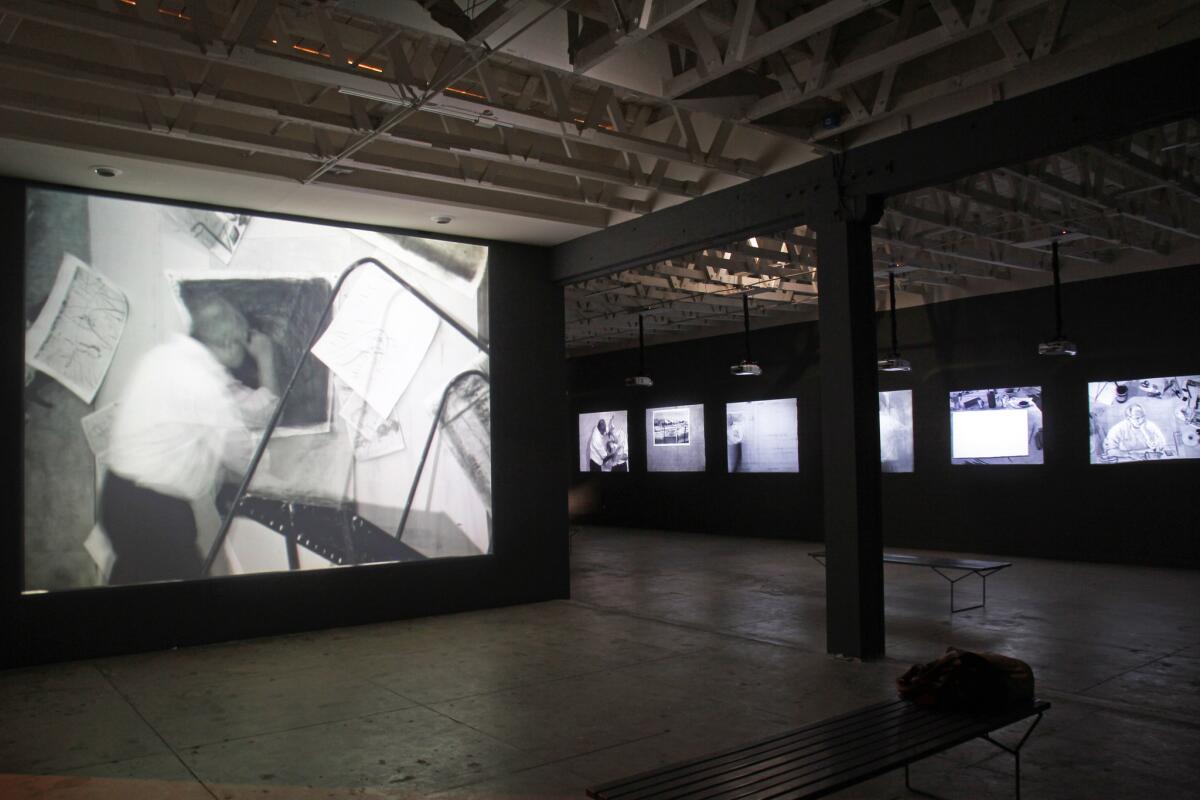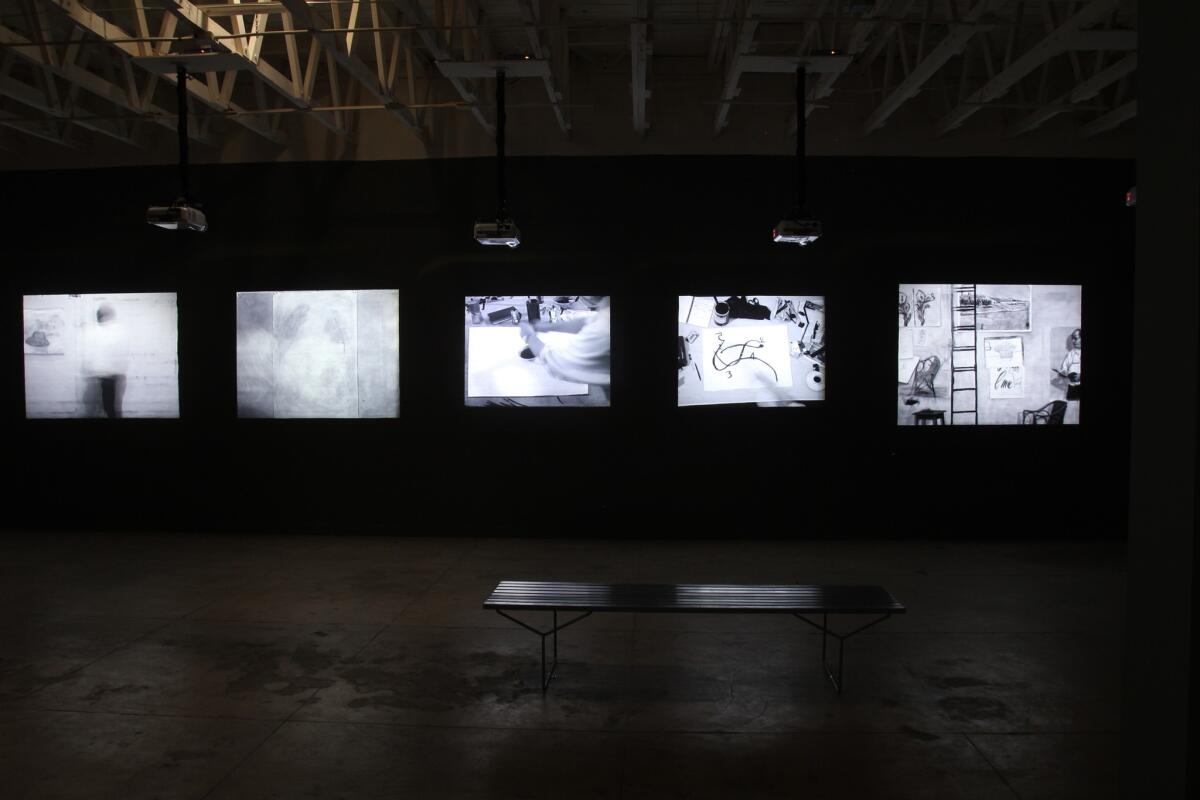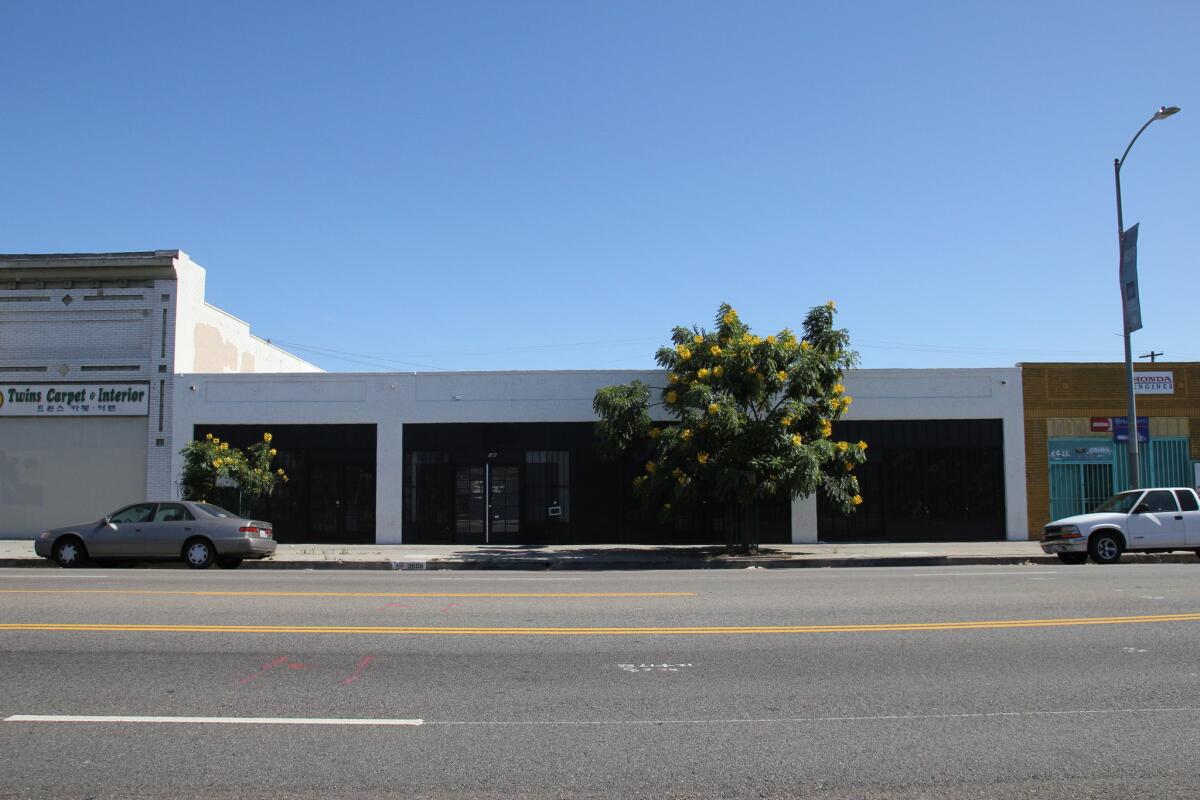An unassuming storefront. A major museum. A collaboration that takes museum art to the people of L.A.

Over the next three years, the Underground Museum, an alternative art space in L.A., will showcase works from MOCA’s collection chosen by painter Noah Davis. The first exhibition is an installation of video by South African artist William Kentridge.
- Share via
Watching William Kentridge’s video installation “7 Fragments for George Méliès” is like watching a bunch of ghosts play with the materials of art. In this suite of seven videos, ink flows backward. Torn scraps of paper levitate and reassemble themselves. Drawings come magically to life.
Kentridge is a highly regarded South African artist who has had exhibitions at the Museum of Modern Art in New York and the Louvre in Paris. “7 Fragments,” a tribute to Méliès, the French special-effects pioneer, was made in 2003 and is in the permanent collection of various international museums, including the Museum of Contemporary Art in Los Angeles.
The piece is on view in L.A., but it can’t be found at any museum.
Instead, for the last three weeks, “7 Fragments” has been quietly screening inside a low-slung storefront on Washington Boulevard in Arlington Heights, down the block from a tattoo parlor and a liquor store. Showing alongside it are two companion videos by Kentridge that are also part of MOCA’s permanent collection.

An installation view of “Journey to the Moon,” a series of video works by the South African artist William Kentridge at the Underground Museum.
The installation is part of an innovative new collaboration between the Underground Museum, the alternative art space founded by painter Noah Davis, and the Museum of Contemporary Art. For the next three years, the Underground will feature a series of exhibitions, curated by Davis, that will be drawn from MOCA’s permanent collection — placing important works of art in a largely working-class black and Latino neighborhood at the heart of Los Angeles.
“Noah said that it had been this huge dream of his to have the Underground Museum have museum-quality work,” says MOCA chief curator Helen Molesworth. “I had been thinking about wanting to do things with artists, to have the museum do things that the artists couldn’t do themselves, that they needed resources or expertise that we could bring to the situation.”
Founded in part by artists, MOCA has long referred to itself as an “artist’s museum.” And Molesworth, who joined MOCA late last year, says that Davis articulated his idea — of showing museum quality work at the Underground Museum — right at a moment in which she was considering what being an “artist’s museum” meant.
She floated the idea of a collaboration to MOCA Director Philippe Vergne, who immediately supported it. “Both Philippe and I feel very strongly that if you follow the artists, you will be in the right place,” she says. “That’s what it means to be an artist’s museum.”

The Underground Museum occupies a storefront in the Arlington Heights section of Los Angeles. There is no sign. Only an open door that leads to a cozy library, a garden and a vast exhibition space.
For Davis, the project comes at a delicate time. The artist is gravely ill with a rare cancer. (He was therefore unavailable to be interviewed.) But he has laid out a road map for future projects with Molesworth, as well as with his brother, video artist Kahlil Joseph, who has the installation “Double Conscience” on view at MOCA.
Joseph is a regular presence at the Underground Museum. He does video production work out of an office in the back. And, in fact, it was at the museum where Molesworth saw his Kendrick Lamar-inspired video piece, “m.A.A.d.” for the first time.
Joseph says that his brother’s artistic instincts extend well beyond what you might see on his canvases. “Noah’s imagination, his vision, his appetite — it’s huge,” he says. “People see him as this black figurative painter and black abstract painter. But it’s like he’s so much more than that.”
The Underground Museum hasn’t just been a space for Davis to make and show art, but something that is a work of art itself — a place to create crackling dialogs between his work and that of other prominent artists, as well as the surrounding neighborhood.
“We’re not a gallery,” says Joseph. “Nothing is for sale. It’s not a museum, which can be alienating. It’s just very honest. The rigor is real.”
“What [Helen] understood,” he adds, “is that the Underground Museum is [Noah’s] magnum opus.”
The Seattle-born Davis, 32, is an accomplished painter. He is well known for producing tension-filled, figurative scenes that often seem to slip into unreality. His paintings figure in the collections of the Nasher Museum in North Carolina, the Rubell Family Collection in Miami and the Studio Museum in Harlem.
The Underground Museum represents another, lesser-known facet of his artistic practice.
In 2012, he took over several connected storefronts on Washington Boulevard — spaces that had once served as a pupusería and a storefront church — knocking down walls, building a garden out back, and establishing a community library stocked with art books and vinyl records.
“In the early stages of the Underground, people were like, ‘What are you doing?’” recalls Joseph. “‘Why are you spending your money on this?’ Everyone was asking [Noah] what the point was. Even I was scratching my head. He was operating purely on instinct.”
But in this space, Davis proceeded to organize a series of exhibitions that caught the eye of both critics and museum curators with their sophistication and their sweeping view of history.
In 2013, he created an installation titled “Imitation of Wealth,” in which he re-created works by blue-chip artists, including a Marcel Duchamp bottle rack and a vacuum cleaner piece by Jeff Koons. The impetus was to display valued cultural artifacts in an unlikely location.
“I bought a vintage Hoover vacuum cleaner off Craigslist for $70 that was the exact design of the Jeff Koons,” Davis told Art in America. “At that time there had been a string of shows in New York and Los Angeles that took the premise to destroy big high-end galleries and create crack dens or whatever.... I liked the idea of bringing a high-end gallery into a place that has no cultural outlets within walking distance.”
Last year, he followed up with an exhibition called “The Oracle,” a show that brought together a range of contemporary and historic works: sculptures by the esteemed Henry Taylor, 19th century carvings from the Sudan, totemic ceramic pieces by Ruby Neri, and Joseph’s “m.A.A.d.” video, an extraordinary multichannel rumination on the real and the imagined in the city of Compton.
In her review of the show, LA Weekly critic Catherine Wagley described it as an exhibition that made connections “between old rituals for side-stepping bad energy and new ones,” all while generating an accessibility that is “often what’s missing from conversations about art.”
“We are still feeling the effects of that show,” says Joseph. “That’s where the ‘m.A.A.d.’ piece was that went to MOCA. That’s how Noah met Helen. And that’s when [MOCA] began to understand what the Underground was all about.”
“Noah has an enviable curatorial sensibility,” says Molesworth. “He has a way of making shows that spin the meaning of the titles around.”
For their collaboration, Molesworth gave Davis the book she describes as “the bible,” the behemoth three-ring binder that lists every work in MOCA’s nearly 7,000-piece collection. After combing through the binder, Davis came up with roughly a dozen exhibition proposals for the Underground Museum — starting with Kentridge, which will be on display into November.
This first show went up without any fanfare. “What’s cool about it is its low profile,” says Molesworth. “It’s the word of mouth way people hear about it.”
Over the next three years, the Underground Museum will display one to two Davis-curated exhibitions a year — some of which are more abstract; others more topical. The museum is reviewing the concepts for feasibility. Among them: a show titled “Non-Fiction,” in which a variety of works from MOCA’s collection would be displayed on wallpaper designed by conceptual artist Robert Gober that shows a black man hanging from a tree.
The idea, says Molesworth, is “that the Underground takes the lead and we take the back seat.”
Part of the plan is also to bring Davis and the Underground Museum to MOCA. The museum is launching a project this summer titled “Storefront,” in which various artist-run spaces from around Los Angeles will be invited to take over a storefront-type space that resides across the courtyard form the museum’s bookshop on the Grand Avenue campus.
The first exhibition, opening in August, will be a reprise of Davis’ “Imitation of Wealth” show from the Underground Museum. Next February, the arts group Public Fiction will take over the space for a series of interactive projects. All of these shows will be accessible separately from the main museum and will be free of charge.
“It’s all very organic,” says Molesworth. “It’s an experiment. It could be wildly successful. It could fail in a way that we learn a lot from.”
Regardless, she is committed to executing Davis’ vision over the next three years — whatever may come.
“We were talking about what would happen if he dies,” she says. “I told him, ‘I’m your curator. And I’m the curator of a lot of work where the artist is not present.’ At the Latin root of [‘curate’] is ‘to care for.’ And while I’m not in any way prepared for Noah to leave us as soon as he might, I’m prepared to do the work of tending to his work. And there are a group of people around Noah who are prepared to tend to the work.”
Joseph says that his brother’s indefatigable spirit will guide him.
“The Underground Museum was bigger than Noah in a way,” he says. “It’s all spirit. And spirits can often take things way further than a person can. If that’s God’s plan, and Noah becomes spirit, and not a very limited human being, my money is that he’s able to do more on the other side.”
“William Kentridge: Journey to the Moon,” is on view at the Underground Museum through Nov. 15. 3508 W. Washington Blvd., Arlington Heights, Los Angeles, theunderground-museum.com.
Find me on Twitter @cmonstah.
More to Read
The biggest entertainment stories
Get our big stories about Hollywood, film, television, music, arts, culture and more right in your inbox as soon as they publish.
You may occasionally receive promotional content from the Los Angeles Times.











